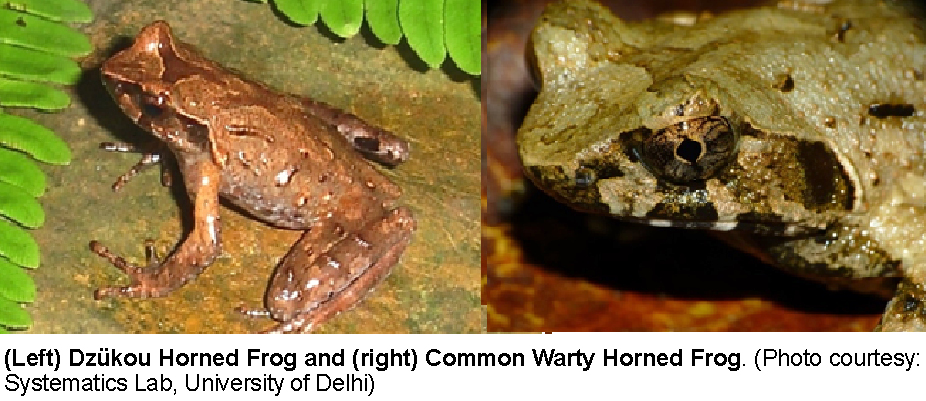Scientists discover 3 new species of horned frogs in NE

2 from Nagaland, 1 from Manipur
Morung Express News
Dimapur | April 30
Scientists have discovered 3 new species of horned frogs of the genus Megophrys or Asian Horned Frogs in the north east. Two were found in Nagaland and one from Manipur’s Tamenglong district. Asian Horned frogs are known to be endemic to south-east Asia, the north east region of India as well as Nepal and Bhutan.
The discovery was made by a team of Irish and Indian biologists from the University College Dublin (Ireland), the Natural History Museum (UK), and University of Delhi. Their work was published in the Journal of Natural History on April 28.
The a member of the research team includes Dr Rachunliu G Kamei, a Naga Herpetologist.
The newly discovered frogs, previously not known to science, have been named Megophrys awuh (Naga Hills Horned Frog), Megophrys numhbumaeng (Tamenglong Horned Frog) and Megophrys dzukou (Dzükou Valley Horned Frog).
The first was found in Meluri, the homeland of the Pochury tribe and in whose language ‘awuh’ means frog.
The name of the second was derived from the Rongmei (Ruangmei) word ‘nwmbwmaeng,’ meaning “forest spirit.” The Rongmei is the primary native tribe from the Tamenglong district of Manipur.
The third species was named “after the only place that this potentially endangered new species was found that lies on the border of Nagaland and Manipur states,” stated a press release informing of the new findings.
The discovery was made when the biologists were investigating a group of small species of horned frogs from Northeast India. “For well over a century, up until 2007, most small horned frogs found from the mountains of Nepal and Northeast India, east to northern Indochina and peninsular Thailand were all assigned to this ‘catch all’ taxonomic name, with the result that this little forest frog was believed to have very wide geographical distribution. However, examining many museum specimens of this little forest frog, and using DNA analyses, the scientists discovered that it actually represented eight different species,” the release said.
It described the work of the scientists as the result of 14 years of research by the lead author Dr Stephen Mahony and seven years of fieldwork in some of the wettest and most difficult terrains in the world by the Indian team. The study was funded by an Irish Research Council EMBARK Scholarship, Irish Research Council-Marie Skłodowska-Curie CAROLINE Fellowship, Council of Scientific & Industrial Research’s (CSIR, India) Senior Research Fellowship, Rufford Foundation Small Grant, and Department of Science and Technology DU/DST Purse Grants from the Government of India.
Dr Mahony is a leading Herpetologist and is also a Fellow of the Irish Research Council and Marie Skłodowska-Curie.
“We have no evidence to suggest that any other scientists has collected or seen the three new species before since we are aware of no other specimens in museum collections,” said Dr Mahony in an emailed response to a message from The Morung Express.
The release further said that the study has dramatically increased the known distribution of four of the five poorly known species of horned frogs. “The Zunheboto Horned Frog (Megophrys zunhebotoensis) was known to science from only two individuals since it was named in 2007 but was found to be widespread in Nagaland and Manipur states. The Common Warty Horned Frog (Megophrys serchhipii) was previously known from a single individual but was found to be even more widespread in the hills of all Northeast Indian states (except Arunachal Pradesh) and neighbouring Bangladesh.”
It quoted Dr Mahony, “This study is a testament to how little is known about the most threatened animal groups, frogs, in northeastern India. Our work has completely changed what we thought we knew about these secretive animals, from how to identify the different species and how they are related to each other, to where they live and how vulnerable they may be to deforestation.”
It also quoted Dr. Rachunliu G Kamei, who was a member of the research team, emphasizing on the vital role frogs play in ecosystems yet “many Nagas still just consider them as tasty snacks.” “The Dzükou valley holds prestige for its natural beauty and is promoted as a tourist attraction. However, increasing tourism brings potential conservation threats to vulnerable endemic species. We named the frog after the valley in the hope that the need for preservation and conservation of the remarkable habitats will resonate with the local people who are the guardians of the valley,” it quoted Dr Kamei.






